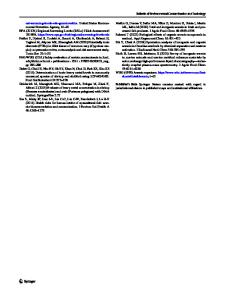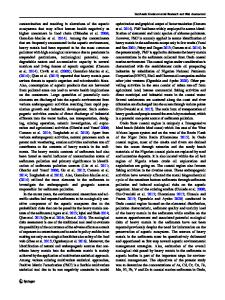Heavy Metals Assessment in Water, Sediments, Algae and Two Fish Species from River Swat, Pakistan
- PDF / 847,286 Bytes
- 7 Pages / 595.276 x 790.866 pts Page_size
- 38 Downloads / 457 Views
Heavy Metals Assessment in Water, Sediments, Algae and Two Fish Species from River Swat, Pakistan Israr Alam1 · Muhammad Nasir Khan Khattak2 · Shahi Mulk3 · Farman Ullah Dawar4 · Lubna Shahi1 · Ihsanullah Ihsanullah5 Received: 31 March 2020 / Accepted: 22 August 2020 © Springer Science+Business Media, LLC, part of Springer Nature 2020
Abstract The heavy metals were studied in water, sediments, algae, and various tissues of Glyptosternon reticulatum and Cyprinus carpio from River Swat, Pakistan, using flame atomic absorption spectrophotometer. The Zn, Cu, Pb and Ni were higher in water at sewage site compared to upstream and downstream sites. In sediments, the Ni and Cd were not detected whereas Cu, Pb and Zn were higher at downstream followed by sewage and upstream sites. The Ni and Zn in algae were higher at upstream and sewage sites compared to downstream site whereas Pb and Cd were higher at upstream site compared to sewage and downstream sites and Cu was found same at all the three sites. The heavy metals (Zn > Cu > Pb and Ni) in tissues (liver > gills > skin > muscles) of G. reticulatum was higher than in C. carpio. This study recommends the proper monitoring of River Swat in order to save its water and inhabitant aquatic life. Keywords Heavy metals · Cyprinus carpio · Glyptosternon reticulatum · River Swat · Algae Toxic waste effluents are serious menaces to the freshwater ecosystem globally, which adversely affects aquatic organisms (Khanna and Ishaq 2013). Contamination of water by heavy metals is a serious problem in terms of its toxicity, bioaccumulation and biomagnifications in the food chain (Galib et al. 2013; Sfakianakis et al. 2015). Water body is the endpoint of pollutants (Edward et al. 2013), where heavy metals enter into the food chains through aquatic organisms such as planktons, invertebrates and fish (Giri and Singh Israr Alam and Muhammad Nasir Khan Khattak contributed equally to this work. * Muhammad Nasir Khan Khattak [email protected]; [email protected] 1
Department of Zoology, Hazara University, Mansehra, Pakistan
2
Department of Applied Biology, College of Science, University of Sharjah, Sharjah, United Arab Emirates
3
Research Center for Eco‑Environmental Science, Chinese Academy of Science, Beijing, China
4
Department of Zoology, Kohat University of Science and Technology, Kohat, Pakistan
5
Nuclear Institute for Food and Agriculture (NIFA), Peshawar, Pakistan
2013). Micro-organisms, micro-flora and algae have capability for bio-accumulation of different metals in their cells. Consequently, small fish after feeding on these organisms, accumulate metals and transfer into higher predators and finally to human beings (Bashir et al. 2013). Thus, aquatic organisms particularly fish are considered bio-indicators for assessment of environment (Giri and Singh 2013) and the measurement of heavy metals in fish is essential for the development of bio-conservation protocols (Kutty and AlMahaqeri 2016). Untreated dumping of industrial and agricultural wastes, growing popu
Data Loading...











